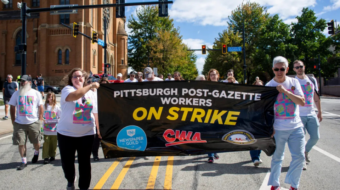Already hopeful because of President Obama’s decision to put former Airline Pilots Association President J. Randolph Babbitt in charge of the Federal Aviation Administration, the nation’s air traffic controllers are finally on their way to getting a new union contract.
The victory will end an eight-year war on controllers and air safety waged by the Bush administration — a war that continued the assault begun by Ronald Reagan when he broke a strike by firing all of the nation’s air traffic controllers.
Obama’s Transportation secretary, Ray LaHood, ordered a panel of mediators, May 19, to draw up a new contract between the FAA and the National Air Traffic Controllers Association. The talks began immediately, NATCA spokesman Doug Church said.
Babbitt, just confirmed as FAA head by the Senate, is trusted by unions in the airline industry. He worked as an independent aviation consultant after his 1990-98 tenure as leader of the pilots’ union. Now, as FAA chief, he said he intends to come to an agreement with the pilots, also.
Speaking during his Senate confirmation hearings, May 19, Babbitt said, “Within the FAA, we need to regain internal labor stability, mutual trust and build on the ‘can do’ spirit of the entire FAA workforce. We need to work to ensure the FAA’s accountability and credibility in delivery of its goals, budgetary compliance and safety standards.”
According to Church the controllers’ union has more than just the LaHood action and Babbitt’s confirmation to be happy about. Church said he was also pleased because, on May 21, the House passed a new FAA authorization bill that makes controllers partners in developing new aircraft control systems.
The labor movement in general, but the Teamsters in particular, also see that FAA bill as a victory. It eliminates a 10-year-old provision, stuck onto aviation law by past GOP-controlled Congresses, that permitted FedEx to classify all its workers, including its truck drivers on the ground, as “airline workers.”
The “airline worker” designation made it much more difficult for the Teamsters, or any union, to organize FedEx.
That is because airline workers and railroad workers are governed by the Railway Labor Act, not regular federal labor law. The Railway Labor Act requires unions to organize all worksites at any company it wants to organize. Regular labor law allows organizing to be done at just one site, if that is what the workers desire.
For a union to be recognized under the Railway Labor Act it must win the votes of 50 percent plus one from all the members of the bargaining unit at all the facilities that are part of the company, not just a majority of those at the site wanting to organize. Any uncast votes are counted as “no” votes.
The Obama appointments, the initiation of the mediation process and the House passage of the bill are all seen as cause for celebration by the controllers’ union, which represents 14,000 controllers and other FAA employees. More than 2,000 experienced veteran controllers have retired since the Bush-controlled FAA declared an impasse in bargaining in 2007 and imposed its contract on the union.
That contract did not address the poor working conditions controllers have had to deal with, and it slashed pay rates for most veteran controllers and froze pay rates for the rest of the workers.
Church said that LaHood’s selection of Jane Garvey, a former FAA administrator, to chair the mediation panel “indicates it’s obviously one of the priorities of the president [Obama] to get this solved.
“He kept his commitments to us,” Church said of Obama who, when he was a senator, first promised the union at one of its legislative conferences several years ago that he would make ending the battle with the FAA a top priority.
Some 400 pilots fanned out over Capitol Hill May 18 to lobby for the FAA bill that the House passed three days later.
jwojcik @ pww.org









